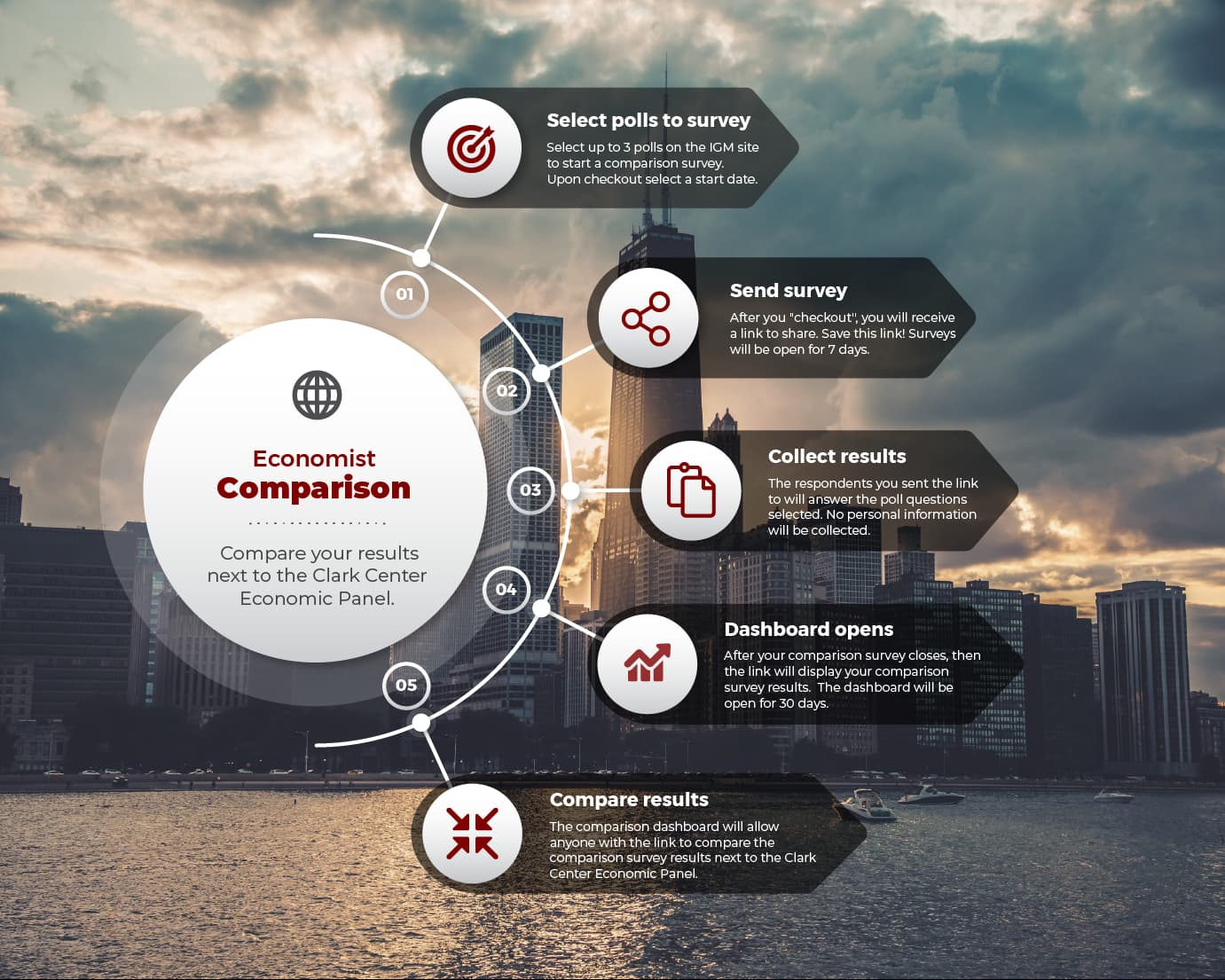Question A:
The large increase in the market for private credit as a substitute for bank finance substantially reduces systemic risk.
Responses
© 2025. Kent A. Clark Center for Global Markets.
10%
3%
0%
33%
44%
10%
0%
Responses weighted by each expert's confidence
© 2025. Kent A. Clark Center for Global Markets.
0%
39%
49%
12%
0%
Question B:
The growth in private credit is substantially higher because of regulations that disincentivize banks from lending to below investment grade private businesses.
Responses
© 2025. Kent A. Clark Center for Global Markets.
10%
3%
3%
0%
23%
56%
5%
Responses weighted by each expert's confidence
© 2025. Kent A. Clark Center for Global Markets.
4%
0%
20%
68%
8%
Question A Participant Responses
Participant |
University |
Vote |
Confidence |
Bio/Vote History |
|---|---|---|---|---|
 John Campbell |
Harvard | Bio/Vote History | ||
|
To the extent that bank C&I lending is reduced by private credit, banks must be lending or investing elsewhere. The question is whether the other assets that end up on bank balance sheets are safer than those displaced by private credit - which is not clear.
|
||||
 John Cochrane |
Hoover Institution Stanford | Bio/Vote History | ||
|
Private credit financed by short-term debt it is not safer than a bank. If a run on one will provoke a run on the others it too can be systemic. Much fintech originates to sell to government agencies too, not a panacea. Either quickly securitized or financed by equity is ideal.
|
||||
 Francesca Cornelli |
Northwestern Kellogg | Bio/Vote History | ||
|
|
||||
 Douglas Diamond |
Chicago Booth | Bio/Vote History | ||
|
Much of the liquidity risk from private credit is still a risk to the banking sector due to contracts between banks and private lenders. Some of the credit risk is indeed removed from banks.
|
||||
 Wenxin Du |
HBS | Bio/Vote History | ||
|
|
||||
 Darrell Duffie |
Stanford | Bio/Vote History | ||
|
This trend is pushing risk out of the banking system, to where the risk is less well regulated and less addressable by central bank backstops. But, private credit involves less short-term funding and less contagion risk. The net impact on financial stability seems uncertain.
|
||||
 Janice Eberly |
Northwestern Kellogg | Bio/Vote History | ||
|
Moving credit out of the banking system reduces some types of risk, but also raises the question of what banks are holding instead and what degree of transparency applies to private credit.
|
||||
 Eugene Fama |
Chicago Booth | Bio/Vote History | ||
|
Not enough information to answer this one.
|
||||
 Xavier Gabaix |
Harvard | Bio/Vote History | ||
|
There's still a real risk of a run
|
||||
 Itay Goldstein |
UPenn Wharton | Bio/Vote History | ||
|
|
||||
 John Graham |
Duke Fuqua | Bio/Vote History | ||
|
|
||||
 Campbell R. Harvey |
Duke Fuqua | Bio/Vote History | ||
|
There is less of a maturity mismatch with private credit given that investors have lock up periods (unlike bank deposits).
|
||||
 Harrison Hong |
Columbia | Bio/Vote History | ||
|
|
||||
 Wei Jiang |
Emory Goizueta | Bio/Vote History | ||
|
|
||||
 Steven Kaplan |
Chicago Booth | Bio/Vote History | ||
|
Direct lending funds and BDCs are leveraged at roughly 50% compared to banks at 85%. And maturities are matched.
|
||||
 Anil Kashyap |
Chicago Booth | Bio/Vote History | ||
|
|
||||
 Ralph Koijen |
Chicago Booth | Bio/Vote History | ||
|
It depends on who holds the private credit instead. If those are, for instance, insurance companies, the risk may shift to another of institutions that may or may not be better positioned to bear the risk.
|
||||
 Camelia Kuhnen |
UNC Kenan-Flagler | Bio/Vote History | ||
|
|
||||
 Andrew Lo |
MIT Sloan | Did Not Answer | Bio/Vote History | |
|
|
||||
 Michelle Lowry |
Drexel LeBow | Bio/Vote History | ||
|
On the one hand, the increase in private credit might decrease systematic risk b/c of diversification: companies can obtain credit through more different channels. On the other hand, it might increase systematic risk because private credit is less transparent and less regulated
|
||||
 Sydney Ludvigson |
NYU | Bio/Vote History | ||
|
lower transparency unlikely to help with systemic risk
|
||||
 Matteo Maggiori |
Stanford GSB | Bio/Vote History | ||
|
|
||||
 Gregor Matvos |
Northwestern Kellogg | Did Not Answer | Bio/Vote History | |
|
|
||||
 Tobias Moskowitz |
Yale School of Management | Did Not Answer | Bio/Vote History | |
|
|
||||
 Stefan Nagel |
Chicago Booth | Bio/Vote History | ||
|
Tentatively agree, but it's worth keeping an eye on how much financing is provided by banks to private credit vehicles.
|
||||
 Jonathan Parker |
MIT Sloan | Bio/Vote History | ||
|
On the one hand, the increase in private credit funds some lending with equity, which is good for systemic risk. On the other hand private credit borrows from banks, which puts greater opacity on the lending funded by bank deposits.
|
||||
 Christine Parlour |
Berkeley Haas | Bio/Vote History | ||
|
Risk is concentrated in unregulated entities
|
||||
 Thomas Philippon |
NYU Stern | Bio/Vote History | ||
|
|
||||
 Manju Puri |
Duke Fuqua | Bio/Vote History | ||
|
Depends; the mix of asset/liability interaction between private credit providers and banks matters.
|
||||
 Michael R. Roberts |
UPenn Wharton | Bio/Vote History | ||
|
|
||||
 Paola Sapienza |
Hoover Institution Stanford | Bio/Vote History | ||
|
Unclear outcome, it may derisk the banking system, but one could argue that valuation is more infrequent in the private credit market - one could argue that this market is more opaque
|
||||
 Amit Seru |
Stanford GSB | Bio/Vote History | ||
|
|
||||
 Robert Stambaugh |
UPenn Wharton | Bio/Vote History | ||
|
|
||||
 Laura Starks |
UT Austin McCombs | Did Not Answer | Bio/Vote History | |
|
|
||||
 Jeremy Stein |
Harvard | Bio/Vote History | ||
|
|
||||
 Johannes Stroebel |
NYU Stern | Bio/Vote History | ||
|
|
||||
 Sheridan Titman |
UT Austin McCombs | Bio/Vote History | ||
|
|
||||
 Stijn Van Nieuwerburgh |
Columbia Business School | Bio/Vote History | ||
|
Private credit is part of shadow banking se tor with less transparency and secondary exposures to systemically risky institutions.
|
||||
 Toni Whited |
UMich Ross School | Bio/Vote History | ||
|
|
||||
Question B Participant Responses
Participant |
University |
Vote |
Confidence |
Bio/Vote History |
|---|---|---|---|---|
 John Campbell |
Harvard | Bio/Vote History | ||
|
|
||||
 John Cochrane |
Hoover Institution Stanford | Bio/Vote History | ||
|
|
||||
 Francesca Cornelli |
Northwestern Kellogg | Bio/Vote History | ||
|
|
||||
 Douglas Diamond |
Chicago Booth | Bio/Vote History | ||
|
Regulation changes are an important part of the growth of private lending, but it is not clear which regulation change is most important. In addition, many other things changed over the last decade. The large increase in liquidity from QE (not yet fully reversed) is important.
|
||||
 Wenxin Du |
HBS | Bio/Vote History | ||
|
|
||||
 Darrell Duffie |
Stanford | Bio/Vote History | ||
|
I agree, but the regulatory disincentives are broader than those specific to high-risk lending. Most types of banking activity have been negatively impacted by post-GFC regulations. These have improved financial stability and reduced credit provision by banks.
|
||||
 Janice Eberly |
Northwestern Kellogg | Bio/Vote History | ||
|
|
||||
 Eugene Fama |
Chicago Booth | Bio/Vote History | ||
|
|
||||
 Xavier Gabaix |
Harvard | Bio/Vote History | ||
|
|
||||
 Itay Goldstein |
UPenn Wharton | Bio/Vote History | ||
|
|
||||
 John Graham |
Duke Fuqua | Bio/Vote History | ||
|
|
||||
 Campbell R. Harvey |
Duke Fuqua | Bio/Vote History | ||
|
|
||||
 Harrison Hong |
Columbia | Bio/Vote History | ||
|
|
||||
 Wei Jiang |
Emory Goizueta | Bio/Vote History | ||
|
|
||||
 Steven Kaplan |
Chicago Booth | Bio/Vote History | ||
|
This is a case where regulation has reduced systemic risk. Ironic that some want to regulate private credit and possibly reverse the benfit.
|
||||
 Anil Kashyap |
Chicago Booth | Bio/Vote History | ||
|
|
||||
 Ralph Koijen |
Chicago Booth | Bio/Vote History | ||
|
|
||||
 Camelia Kuhnen |
UNC Kenan-Flagler | Bio/Vote History | ||
|
|
||||
 Andrew Lo |
MIT Sloan | Did Not Answer | Bio/Vote History | |
|
|
||||
 Michelle Lowry |
Drexel LeBow | Bio/Vote History | ||
|
|
||||
 Sydney Ludvigson |
NYU | Bio/Vote History | ||
|
|
||||
 Matteo Maggiori |
Stanford GSB | Bio/Vote History | ||
|
|
||||
 Gregor Matvos |
Northwestern Kellogg | Did Not Answer | Bio/Vote History | |
|
|
||||
 Tobias Moskowitz |
Yale School of Management | Did Not Answer | Bio/Vote History | |
|
|
||||
 Stefan Nagel |
Chicago Booth | Bio/Vote History | ||
|
|
||||
 Jonathan Parker |
MIT Sloan | Bio/Vote History | ||
|
|
||||
 Christine Parlour |
Berkeley Haas | Bio/Vote History | ||
|
Regulatory arbitrage
|
||||
 Thomas Philippon |
NYU Stern | Bio/Vote History | ||
|
|
||||
 Manju Puri |
Duke Fuqua | Bio/Vote History | ||
|
|
||||
 Michael R. Roberts |
UPenn Wharton | Bio/Vote History | ||
|
|
||||
 Paola Sapienza |
Hoover Institution Stanford | Bio/Vote History | ||
|
Migration has been happening for a long time but it has accelerated after new regulation
|
||||
 Amit Seru |
Stanford GSB | Bio/Vote History | ||
|
|
||||
 Robert Stambaugh |
UPenn Wharton | Bio/Vote History | ||
|
|
||||
 Laura Starks |
UT Austin McCombs | Did Not Answer | Bio/Vote History | |
|
|
||||
 Jeremy Stein |
Harvard | Bio/Vote History | ||
|
|
||||
 Johannes Stroebel |
NYU Stern | Bio/Vote History | ||
|
|
||||
 Sheridan Titman |
UT Austin McCombs | Bio/Vote History | ||
|
|
||||
 Stijn Van Nieuwerburgh |
Columbia Business School | Bio/Vote History | ||
|
|
||||
 Toni Whited |
UMich Ross School | Bio/Vote History | ||
|
|
||||

